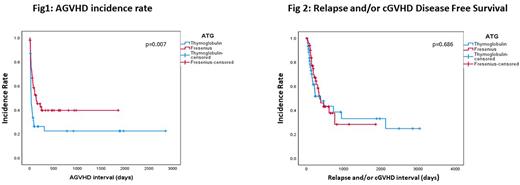Abstract
Background: Graft versus host disease (GVHD) is one of the major complications in allogeneic stem cell transplantation, leading to excessive post-transplant morbidity and mortality. Anti-Thymocyte Globulin (ATG) is a widely used anti GVHD prophylaxis adjunct, in addition to a calcineurin inhibitor and either methotrexate or mycophenolate mofetil. Among available ATG sera are antithymocyte globulin (ATG-T) (Sanofi Genzyme, Cambridge MA), derived from rabbit vaccination with human thymocytes, and the anti-T-lymphocyte globulin (ATG-F) (Neovii, Rapperswil, Switzerland, ATG Fresenius®), derived from the human Jurkat T-cell line. Data comparing the two agents, regarding transplant outcomes is still lacking.
Methods: Since 2015, ATG-F (15 mg/kg) has become the preferred prophylactic agent at the Hadassah medical center. We retrospectively compared the transplant outcomes between 52 patients treated prophylactically with ATG-F (15 mg/kg) during 2015-2018 and 46 patients treated with ATG-T (10 mg/kg), during 2011-2018. Our research aims were directed towards investigating rates of engraftment, infections, GVHD, relapse, and overall survival.
Results
Demographic, disease and pre-transplant characteristics (median age, gender, disease status at transplantation entry, age adjusted comorbidity index) of the two groups were mostly similar. There was no significant difference in median recipient and donor age, and conditioning regimen intensity. There was a higher rate of patients transplanted for MDS and secondary AML in the ATG-F group while a higher rate of lymphoproliferative diseases in the ATG-T group (p=0.038). Comparing patients' characteristics for the available risk factors for GVHD, there was a borderline significant higher incidence of HLA mismatch in the ATG-T group compared to the ATG-F group (39.1% Vs. 21.2%; p=0.052), and a significantly higher number of patients received single agent cyclosporine in the ATG-T group (30.4% vs 3.8%, p<0.01). In terms of risk factors for infections, there was a significantly higher incidence of positive CMV-IgG in both donor and recipient in the ATG-F vs ATG-T group, 82.4% vs 60.9%, p=0.022).
Analyzing transplant outcomes, the incidence of acute GVHD of any grade was significantly higher in the ATG-T group (p=0.007, Fig. 1), while the incidence of grade 3-4 acute GVHD was comparable (p=0.186). Incidence of any grade and moderate-severe chronic GVHD was comparable in both groups (p>0.05). There was no statistically significant difference in disease-free survival and overall survival rates between the groups (p>0.05). A combined analysis of moderate-severe chronic GVHD-free, relapse-free survival (GRFS) showed no difference between the groups (p=0.686, Fig. 2). Median time to absolute neutrophil count (ANC) and Platelet engraftment was 15 vs. 14 and 16 vs. 17 days in the ATG-T and ATG-F group, respectively. There was no difference in the incidence of bacteremia or CMV reactivation between the two groups (p=0.79; p=0.704, respectively).
Conclusion
Our retrospective study shows that ATG-F was non-inferior to ATG-T regarding engraftment rate, incidence of grade 3-4 acute GVHD and moderate-severe chronic GVHD, disease free survival and overall survival. The higher incidence of acute GVHD of any grade detected in the ATG-T group might reflect the higher rate of HLA mismatch and combination with single agent cyclosporine prophylaxis. Study limitations include its retrospective nature and changes in transplant care over the study years.
Disclosures
Nachmias:AbbVie, BMS: Membership on an entity's Board of Directors or advisory committees, Other: lectures. Avni:MSD: Membership on an entity's Board of Directors or advisory committees.
Author notes
Asterisk with author names denotes non-ASH members.


